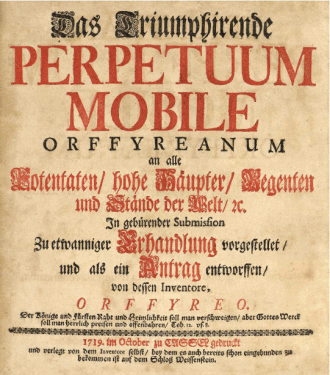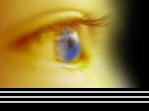|
Triumphans Perpetuum Mobile
Orffyreanum
Full
Title: Das Triumphirende
Perpetuum Mobile Orffyreanum an alle
Potentaten, hohe Häupter, Regenten und Stände der Welt. In gebürender
Submission zu etwanniger Erhandlung vorgestellet, und als ein Antrag entworffen,
von dessen Inventore.
>
In 1719, 2 years after the last demonstration of his machine at Castle of Weissenstein, Kassel, Orffyreus
published his book, The Triumphant Orffyrean Perpetuum Mobile. He wrote it German and Latin.
In his time, the medium of instruction was Latin therefore; Latin text was addressed to the contemporary scientists,
while the German was meant for the public. Book can still be found in the libraries
of the United States, Russia, and Europe. In his book, Orffyreus gives description of his machine without revealing the secret.
He also describes how he started to construct perpetual motion machines. He extols the virtue of his machine working hard, raising and lowering basket of stones
and buckets of water.
He also presents a brief account of history of perpetual motion machines. He praises his patron and supporter,
Karl alone but we are surprised to see that the name of Leibniz who helped him a lot does not appear. He complains about the world and his enemies. He lists his
opponents under four categories: the scientific world, persons in high authority, the public in general, and the press.
John Collins has released recently 'DAS TRIUMPHIRENDE...'now available for purchase -both in hard copy and electronic
format.
Collins version, in his own words: “Das Triumphans
is a more professional-looking publication written in both German and Latin prose and discusses the history of the search
for perpetual motion. It contains reproductions of all of the certificates Bessler won, including descriptions of the tests
carried out at the examinations and the names of the chief examiners. There are also a number of laudatory letters and poems
included. It also has many drawings of the various wheels, which also contain several undeciphered clues to the secret. I
believe that the clues were inserted in case Bessler needed to be able, at some later date, to point to the clues and decipher
them as proof that he was first with a successful PM design. I have deciphered some of the more obscure clues and believe
that more will be solved soon, but some of the other more obvious ones have so far beaten me."
Following excerpts are very remarkable as we find in them, Orffyreus revealing to us
working mechanism of his machine in his own style.
“I put all in fresh order, and began work in all
possible haste, doing everything in the manner of those I had already made and destroyed, with only a few changes in the dimensions
of the so-named turning-wheel. For as a grindstone may be called a wheel, so may the principal part of my machine be named.
The outward part of this wheel is drawn over or covered with waxed linen in the form of a drum. This cylindrical basis was
12 Rhenish feet in diamter, the thickness from 15 to 18 inches, the middle axle 6 feet long and 8 inches in thickness. It
is supported in its movement on two pointed steel balance-pegs, each 1 inch thick; and the wheel is vertically suspended.
The movement is modified by two pendulums, as shown in the engraving at the end of this book. The inward structure of the
wheel is of a nature according to the laws of mechanical perpetual motion, so arranged that by disposed weights once in rotation
they gain force from their own swinging, and must continue their movement as long as their structure does not lose its position
and arrangement. Unlike all other automata, such as clocks or springs or other hanging weights which require winding up or
whose duration depends on the chain which attaches them, on the contrary, these weights are the essential parts and constitute
perpetuum mobile itself; as from them is retreived the universal movement which they must exercise so long as they remain
out of the center of gravity; and when they come to be placed together, and so arranged one against another that they can
never obtain equilibrium, or the punctum quietus which they unceasingly seek in their wonderous speedy flight, one or other
of them must apply its weight vertically to the axis, which in its turn will also move.”
(Quote Source:"Perpetuum Mobile" by Dircks)
" The internal structure of the machine is of a nature
according to the laws of mechanical perpetual motion, so arranged that certain disposed weights, once in rotation, gain force
from their own swinging, and must continue this movement as long as their structure does not lose its position and arrangement."
"
Unlike all other automata, such as clocks or springs, or other hanging weights which required winding up, or whose duration
depends on the chain which attaches them, these weights, on the contrary, are the essential parts, and constitute the perpetual
motion itself; since from them is received the universal movement which they must exercise so long as they remain out of the
center of gravity; and when they come to be placed together, and so arranged one against another that they can never obtain
equilibrium, or the punctum quietus which they unceasingly seek in their wonderfully speedy flight, one or other of them must
apply its weight at right angles to the axis, which in its turn must also move."
Das Triumphirende Perpetuum Mobile Orffyreanum
Johann Bessler, Kassel, 1719, pp. 16-23
Provided by Al Bacon
Translation by Ted of Chicago
“Except for a small change in the external dimensions
of the wheel for raising weights (or so-called "running wheel"), I have organized everything together in accordance with those
structures of the previous machine which I had broken to pieces. These small changes occurred by chance and do not need to
be defended.
Around the firmly placed horizontal axis is a rotating
disc (or lower cylinder) which resembles a grindstone. This disc can be called the principle piece of my machine. Accordingly,
this wheel consists of an external wheel (or drum) for raising weights which is covered with stretched linen. The base of
the cylinder is 12 Rhenish feet in diameter. The height (or thickness) is between 15 and 18 inches. The axle (or shaft) passing
through the center is 6 feet long and 8 inches thick cross-sectionally. While in motion it is supported by two almost one-inch-thick
tapered steel pegs, whose two bearings (or sockets) with two curves around the axle provide the rotational motion of the whole
vertically suspended wheel through application of pendula, which can be somewhat modified, as the attached figures at the
end of this treatise clearly show. The internal structure of this drum (or wheel) consists of weights arranged according to
several a priori, that is, scientifically demonstrable, laws of mechanical perpetual motion. After the wheel completes a single
rotation, or after a single force is applied to the wheel, the motion drives the wheel unceasingly. As long as the wheel’s
whole structure does not change, the wheel continues its revolutions without any further assistance from external motive power.
Other automatic machines, such as clockwork, springs, and hoisting weights, necessarily require an external restoring force.
The upper weight is not attached to an external mechanism, nor does it rely on external moving bodies by means of whose weight
revolutions continue as long as the cords or chains on which they hang permit. As long as it remains outside the center of
gravity, this upper weight incessantly exercises universal motion from which the essential constituent parts of the machine
receive power and push. These parts are enclosed in a case and are coordinated with one another so that they not only never
again reach an equilibrium (or point of rest) for themselves but incessantly seek with their admirably fast swing to move
and drive on the axis of their vortices loads that are vertically applied from the outside and are proportional to the size
of the housing. The mechanical wheel not only bears the name of the long sought perpetual motion machine; it deserves to be
named for such motion. It uses one of the best known implements for mechanical power, namely, a true circular wheel which
rotates about its central axis.
Special trials have demonstrated for eyewitnesses that
this mechanical wheel is a self-rotating system of several heavy bodies and will be as long as the bodies remain heavy and
the universe exists.”
- Johann E. E. Bessler, 1717

|


